The Victor-Victrola Page

An Introduction to Vibro-Acoustics
This page provides a general discussion on the topic of Vibro-Acoustics for those who have had little or no previous exposure to this field. I will attempt to avoid complex mathematics to the extent possible, and hopefully will provide a basic background to this topic in terms that are easily understood. Most people are familiar with the terms "sound" and "vibration". These two phenomena are inseparably linked. Sound is always caused by vibration. We can feel the vibration when we touch the surface of a loud stereo speaker or almost any rotating machine. Some structure or object must be vibrating in order for sound to occur.
Another "ingredient"
necessary for the presence of sound is an elastic medium for the energy to travel through
from the vibrating source to our ears. In the case of this discussion, the
elastic medium is air. When an object vibrates, it disturbs the air molecules
surrounding it. These molecules bump into one
another and cause a tiny change in the instantaneous air pressure that our ears
can hear as sound.
Vibration is measured as the motion of a structure as a function of time. Sound
is measured as the change in air pressure as a function of time. When an object
vibrates, only a tiny fraction of the vibration energy is
converted into sound energy; some surfaces are more efficient sound radiators than others, resulting in more sound energy being generated.
In recent years, vibration and acoustic measurement instrumentation has improved dramatically. Precision
instrumentation microphones are now used to
measure sound characteristics, and devices called accelerometers are
used to measure structural vibration. In addition, laser beams can be used
to monitor the motion of a small surface without the need to physically connect
a sensor to the surface itself. These measurement systems, along with the
extremely sophisticated signal processing capabilities of modern computerized
analyzers allow us to take a very detailed look at the performance of
vibro-acoustic devices (such as phonographs), which was absolutely not possible
for those engineers who designed Victrolas over 100 years ago. They developed
products based on "trial and error" experimentation, and used their ears as the
sole means to determine the results of their efforts.
The Propagation of Sound
Sound radiates from the vibrating source in all directions. The effect is similar to dropping a stone into a quiet pond;
the sound pressure waves move out in concentric rings from the center source. However, this analogy is
a bit of an oversimplification. In order
to understand how sound actually "moves", it is necessary to look at the air molecules themselves. If we look at a single air molecule
that is being excited by sound (Figure 1) we can see that the molecule oscillates about its equilibrium position. It simply moves
back and forth; it does not travel along a path from point to point in the listening room. However, the
moving molecule will strike neighboring molecules, and thus propagates the disturbance. The
adjoining molecules now also oscillate about their center points, having been excited by
the original molecule. This exchange of energy from molecule to molecule is what we hear as sound. It is actually tiny fluctuations in
pressure caused by this propagating molecular motion.

Figure 1. Air molecule motion. Each molecule moves back and forth, bumping into adjoining molecules, and then returning to its center point.
When a solid object vibrates, it moves back-and-forth by a small amount about a center point. The motion compresses local air molecules as the object moves one way, and decompresses them when it moves back the other way (see Figure 2). The compressed molecules bump into the adjoining molecules, and these neighbors become compressed, likewise squeezing against their neighbors. With each impact, a small amount of energy is lost, so this process continues in chain-reaction style, slowly losing energy until it fades away. Thus, the farther you are away from a sound source, the less audio volume you hear. Looking at this process on a broader scale, the pressure moves out from the source in the form of a wave.
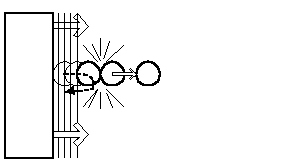
Figure 2. Molecule motion during compression. The vibrating structure moves the molecule, which impacts
adjoining molecules in a "chain reaction" motion. When the structure moves in the opposite direction, the molecules move back in a similar fashion, one following the other.
This resultant sound wave can be visually depicted as shown in Figure 3. As the millions of molecules surrounding the vibrating structure squeeze together and then spread apart, the sound wave spreads from the source in all directions, alternating as low pressure and then high pressure transitions through space. When the molecules are squeezed, the pressure is high. When they are decompressed, the pressure is low. Under normal conditions, the pressure waves move at approximately 1,125 feet per second (the speed of sound). If we were to place a very sensitive pressure sensor in this path and measure the pressure changes, we could determine the magnitude of the sound wave. That is exactly what a microphone does. The greater the magnitude of the pressure fluctuations, the louder the sound is to our ears.
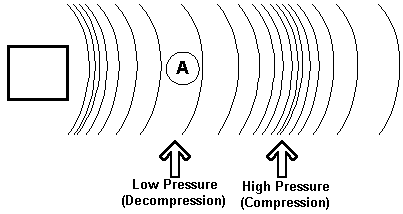
Figure 3. The box is vibrating and causing molecules to compress and decompress in a chain reaction. These pressure changes move away from the
box through space. If we were to stand a point "A", we would experience low pressure and high pressure waves move past us at the speed of sound.
Finally, the term acoustic impedance needs to be addressed. This concept is quite complex, but basically relates to the
amount of resistance
that a sound pressure wave experiences when it travels across different materials and through different spaces. If the
sound wave transitions
from a space with one impedance (e.g. a small tube) into a different space with a different impedance
(e.g. a large room), the wave
loses energy and tends to be reflected backwards. This concept will be discussed in detail in the technical articles relating to horns and tonearms.
Frequency
One common element to both sound and vibration is the concept of frequency.
In vibration, frequency is defined as the number of times a vibrating structure
moves back and forth during one second. It is commonly measured in units of
Hertz. A frequency of 1 Hertz means that the object moves back and forth once during one second. A frequency of 1000 Hertz means that the object
vibrates back and forth 1000 times per second. Subjectively, we hear lower frequencies as a
"bass" pitch and higher frequency as "treble" pitch. For sound waves, frequency
relates to the duration (in fractions of a second) that it takes for the passing sound waves to go from low pressure to high pressure and
back to low pressure again. If a local vibrating structure is the source of a sound we hear, its vibrational frequency is the same as the
frequency we hear through the resulting sound wave. If we were standing at Point
A in Figure 3 (above), we have already stated that the sound waves travel past
us at 1125 feet per second. If the structure is vibrating at low frequencies, the spacing between the compression and
decompression parts of the sound wave would be much farther apart then it would be for high frequencies. To calculate the distance
between the compression and decompression points in a soundwave (or one-half wavelength) for any given frequency, the simple
formula;
Distance (in feet) = 1125/(2 x frequency)
Thus, for a 100 Hertz tone, the distance between the high pressure point and low pressure point is:
1125/(2 x 100) = 1125/200 = 5.625
feet, The wavelength, or spacing between one high-pressure point and
the next high-pressure point is 2 X 5.625 = 11.253 feet.
Thus, even though the sound wave (molecule-to-molecule impacts) moves past us at a fixed speed, the time it takes to go from low
pressure to high pressure at a fixed point is dependent on the frequency of the source. This is because the distance
(spacing) between the high and low pressure points varies as a function of frequency. Again, lower frequency sounds have more
distance between the high and low pressure points in the sound wave. The number of pressure cycles that pass by the listener in one
second is the frequency or pitch that we hear.
Human hearing has a limited range of response; an "ideal" ear can hear from approximately 20 Hertz up to 20,000 Hertz, but in
reality, most people over the age of 20 have a hearing response in the range of 20-14,000 Hertz, rapidly decreasing with age. As a
reference, the fundamental tone of A above middle C on a piano is 440 Hertz. When struck, the piano string vibrates at that
frequency, and excites the nearby air molecules, causing a pressure wave of 440 Hertz to be passed to the listener. A doubling of the
frequency is an octave. Thus, the next A on the piano (above the A440) has a fundamental frequency of 880 Hertz, an octave
higher. Move to the A below middle C, and you will measure 440/2, or 220 Hz.
The vast majority of sounds that we encounter in everyday life occur in the range of
50 to 5000 Hertz. This includes the fundamental
tones of most musical instruments. Sounds below 50 Hertz may be heard in the lowest notes of pipe organs or in the rumble of distant
thunder. Sounds above 5000 Hertz are heard as the "sizzle" in cymbals or in some of the high overtones of a violin. If you play an
orchestral recording through a high quality stereo system with an equalizer, you can experiment with the frequency content of the
recording. Cutting out frequencies above 12,000 Hertz tends to reduce the subtle presence of the orchestra more than it affects
the sound quality of the instruments themselves. Even when you cut out frequencies above 5,000 Hertz, most of the audio content of
the orchestra is still present, although with much less sparkle or "life".
Audio recordings from the early years of the 20th Century usually have a
frequency response range from approximately 100 Hz to 3,000 Hz, depending on the
equipment that was originally used. This is one reason that old 78 RPM
recordings sound "canned". Much of the frequency content that we are used to
hearing in new recordings is lost in those old records.
Amplitude
Another term that is common to both vibration and sound is the concept of amplitude. In vibration, amplitude refers to the maximum
motion that a structure moves as it vibrates. Vibration motion can be defined in terms of displacement (inches), velocity (inches per
second), or acceleration (g's). Refer to Figure 4. In this example, this tuning fork is vibrating. If we could use a imaginary magnifying
glass, we could see the tiny motion of one of the fork's tines as it vibrates back and forth. In this case, the fork tine is moving left from
center a small distance "Y" and right from center the same distance "Y" as it vibrates. If we were to track the motion of one of the
tines as we moved it through space (or if we dragged it along a piece of paper), we would end up with a "sine wave" pattern, as shown in the example. The sine wave has a
distinctive shape. It's maximum amplitude (or peak value) is "Y", the same amount as the tine moves as it vibrates.
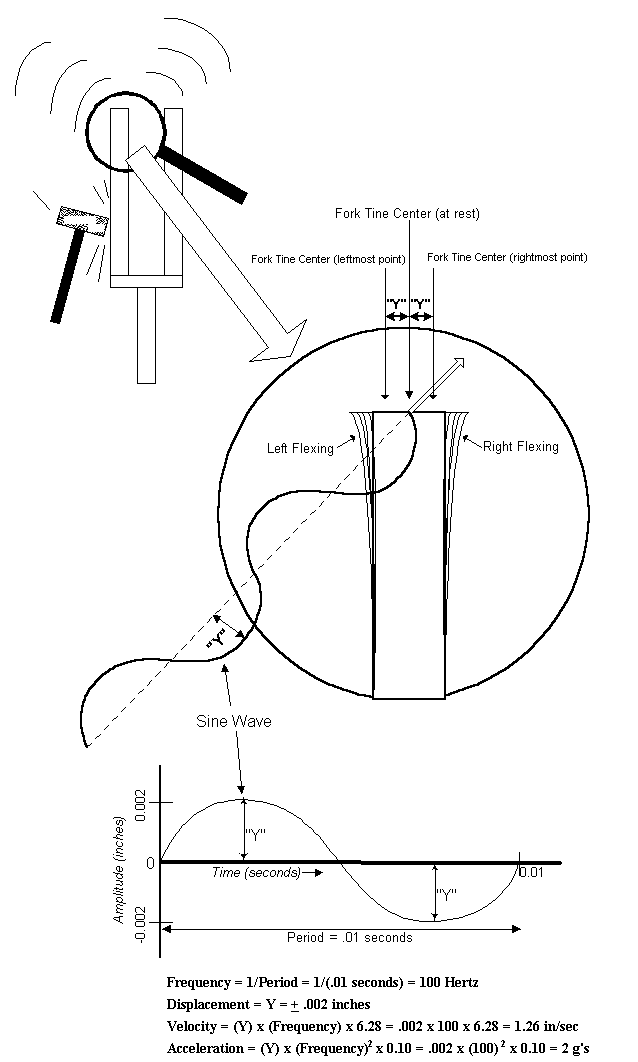
Figure 4. The tuning fork vibrates back and forth. If we were to view this motion through a magnifying glass as we moved the fork through space, a
sine wave would be produced. This wave can be evaluated to determine its displacement, speed or acceleration.
If we were to look "straight on" to this sine wave shape, we would see a curve as shown on the bottom of Figure 4. In this example,
we used specialized measurement instruments to measure the amplitude (value of "Y") as being 0.002 inches (2/1000 inch). We also
were able to measure the length of time that it takes for the sine wave to complete one cycle
(move from rest in one direction, then the other direction, and back to the rest position again), and found it to be 0.01 seconds (1/100 second). This time
measurement is known as the
wave's period.
Once these simple parameters are measured, we can understand a great deal about the vibration of the tuning fork. For example, if
we take the reciprocal of the period, we can determine the fork's frequency. In this example, the
fork is vibrating at 100 Hertz (or 1/.01).
We already measured the amplitude of the displacement as being .002 inches. If we are
interested, we can simply apply the equations shown at the bottom of the figure to calculate the
fork's velocity (or speed) in inches per second as it vibrates. In this case, the
tine vibrates at a peak speed of 1.26 inches per second. Alternatively, we could calculate its
acceleration. The tine's peak
acceleration as it vibrates is 2g's, twice the acceleration of gravity. Note
from these equations, as the frequency rises, so does the velocity and
acceleration; if the fork is vibrating back and forth more times in a second, its velocity has to
increase accordingly. The important thing to bear in mind here is that any of these parameters (displacement, velocity or acceleration) can be used to describe vibration. Once
we know the frequency of vibration and any one of these parameters, we can easily calculate the others using
these simple equations.
For sound waves, the term amplitude relates to the levels of maximum pressure fluctuation in the sound wave. The base unit for sound
pressure is the Pascal. One Pascal is equal to approximately 0.000145 pounds per square inch (PSI)
of pressure. For example, a typical
conversational voice generates approximately 0.063 Pascals of sound pressure. A whisper would generate 0.0011 Pascals, while a
747 jet during take-off could produce as much as 6,500 Pascals (0.95 PSI) of sound pressure. Using these pressure units to measure
sound are somewhat unwieldy, since the human ear does not respond to sound pressure in a linear fashion. In other words, a sound
pressure of 2 Pascals would not sound as twice as loud as a sound pressure of 1 Pascal. Thus, most practical measurements of sound
levels use decibels as the units of measure. The decibel is a calculation based on taking the logarithm of the Pascal measurements,
defined as:
dB = 20 log10 (Sound Pressure measured in Pascals / .00002)
The dB is used because it better corresponds to subjective human hearing response. Using these units, the typical conversation
measures in at 70 decibels, the whisper is 35 decibels, and the 747 jet measures in at 170 decibels. The important thing to remember
with decibels is that the subjective sound level doubles for each 10 decibel increase. In other words, 70 decibels sounds twice as loud
as 60 decibels, 100 decibels sounds twice as loud as 90 decibels, etc. The use of A-weighted decibel measurements is more
accurate for determining subjective sound levels because it takes the human ear's frequency response characteristics into account.
Complex Waveforms
Most sound and music that we hear does not consist of simple tones (e.g. a pure
sine wave). When multiple
frequencies are present at one time, the result is a complex waveform. The sine wave shown in Figure 3 is a simple 100 Hertz tone. If you could hear it, it would sound similar to the
effect one hears when blowing across the mouth of a large jug. It's a rather
boring sound. However, if one were to look at the waveform of a harp string plotted
against time, it would look similar to the bottom plot in Figure 5. This is due to the presence of
harmonics in the harp's vibrations. Musical instruments, human voices
and most sounds in nature have high harmonic content. Harmonics are multiples of a
fundamental frequency, and give musical instruments their unique sound quality; it makes a flute sound like a flute and a trumpet sound like a
trumpet. For example, if a piano plays an "A" at 440 Hertz, it will have some
harmonic content. That means that the piano will produce not only the 440 Hertz "A" tone, but also 880 Hertz (the second harmonic) and
1760 Hertz (the fourth harmonic) of that note. A trumpet playing the same "A" at
440 Hertz would have different harmonic content, and thus, while
we still hear an "A" coming from both instruments, they sound very different to the ear. When many instruments are playing at once, the
waveforms can become infinitely complex, but our ears are capable of discerning
much of the harmonic content. Thus we can hear a piano playing in front of a
large orchestra. No matter how complex the sound waves become, they can always be broken down into many individual sine wave components
via modern computerized systems for
detailed analysis.
Harmonics are always caused by some amount of flexing (distortion) in the
vibrating structure. That would include the flexibility in a piano string, a
trumpeter's lips, or in the human voicebox. But when components used in sound reproducing equipment flex, they tend to
add additional (unwanted) harmonics to the reproduced sound, and we term this phenomena
harmonic distortion. In other words, when we listen to music, we expect
to hear the distortion that the musical instruments naturally produce, but we
don't want the reproduction system to add its own distortion characteristics to
the sound.
A simple example of a complex waveform is seen in Figure 5. The upper plot shows a simple sine wave with a period of 0.002
seconds, or 500 Hertz. The second plot is a sine wave that completes 3 complete cycles in the same 0.002 seconds, so its period is
.002/3 or 0.00067 seconds. This equates to a frequency of 1500 Hertz (3 times higher than the first plot). Thus, the second plot is the
third harmonic of the first plot. If these two curves were combined, the complex waveform on the bottom would result.
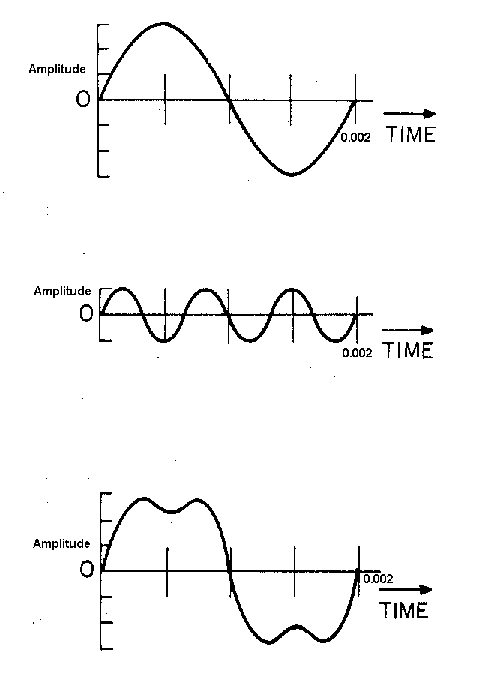
Figure 5. The complex waveform on the bottom is the summation of the two simple waveforms above it.
Other complex waveforms are generated when a transient event occurs. A good example of a transient event would be the "click" heard on a phonograph record due to a scratch or other defect. The resulting waveform would be as seen in Figure 6. There is a sudden discontinuity in the waveform due to the sudden impact of the needle through the scratch. Analysis of this waveform might include the amplitude and duration of the transient event.
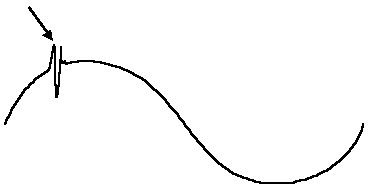
Figure 6. The transient event (denoted by arrow) disrupts the "smooth" flow of the waveform.
Measurement Instrumentation
Many specialized instruments are available to study the effects of sound and vibration, and to measure and compare the performance
of sound reproduction equipment. The microphone (mentioned above) is used to measure the sound pressure fluctuations at any point
in the listening room. Small accelerometers can be attached to surfaces to measure the vibration of a structure, and can produce
output signals proportional to the structure's acceleration, velocity or displacement. Laser
beams can be pointed at vibrating objects and measure the amount of motion and frequency content of the vibrations.
But the "key" to evaluating all this data is the Signal Analyzer, a computerized instrument that allows the engineer to make comparative
measurements, and evaluate these signals in an infinite number of combinations. Signals can be viewed in terms of amplitude or
frequency. Displacements and pressure levels can be easily determined. When processed, this data can show the weak links and
performance characteristics of sound reproduction equipment and components, and direct the analyst to
understand the reasons why certain
components produce certain sound qualities.
One of the most important tools that the acoustic analyst uses is the FFT, or
Fast Fourier Transform technique. Basically, this process
converts a sine wave into its frequency and amplitude components, represented as a single "bar" for each simple sine wave. If we
were to look at the FFT measurements of the 3 sine waves in Figure 5, the results would appear as shown in Figure 7. The FFT
analysis allows us to breakdown the simple (or highly complex) waveforms to determine the frequency and amplitude content in each
waveform. This is a highly valuable aid in measuring and comparing the sound and vibrations from any source.
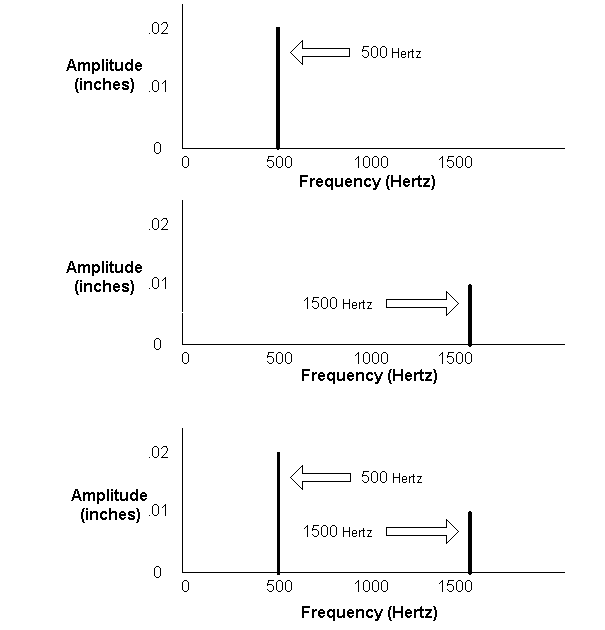
Figure 7. FFT Representations of the sine wave plots of Figure 5 (above). The upper plot shows that the topmost sine wave has a frequency of 500
Hertz, and an amplitude of .02 inches. The middle plot shows that the center sine wave has a frequency of 1500 Hertz (3 times the frequency of the
top sine wave) and an amplitude of .01 inches (one half the amplitude of the top sine wave). The bottom FFT shows the
breakdown of the complex bottom sine wave as being the sum of the two individual sine waves. In this manner, the frequency and amplitude of any waveform can be easily
evaluated.
These types of measurements will be presented in the Technical Analysis pages, to assist in understanding the design characteristics and comparative performance of antique phonographs.

